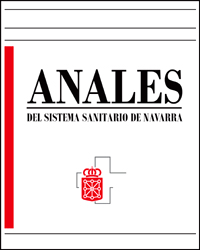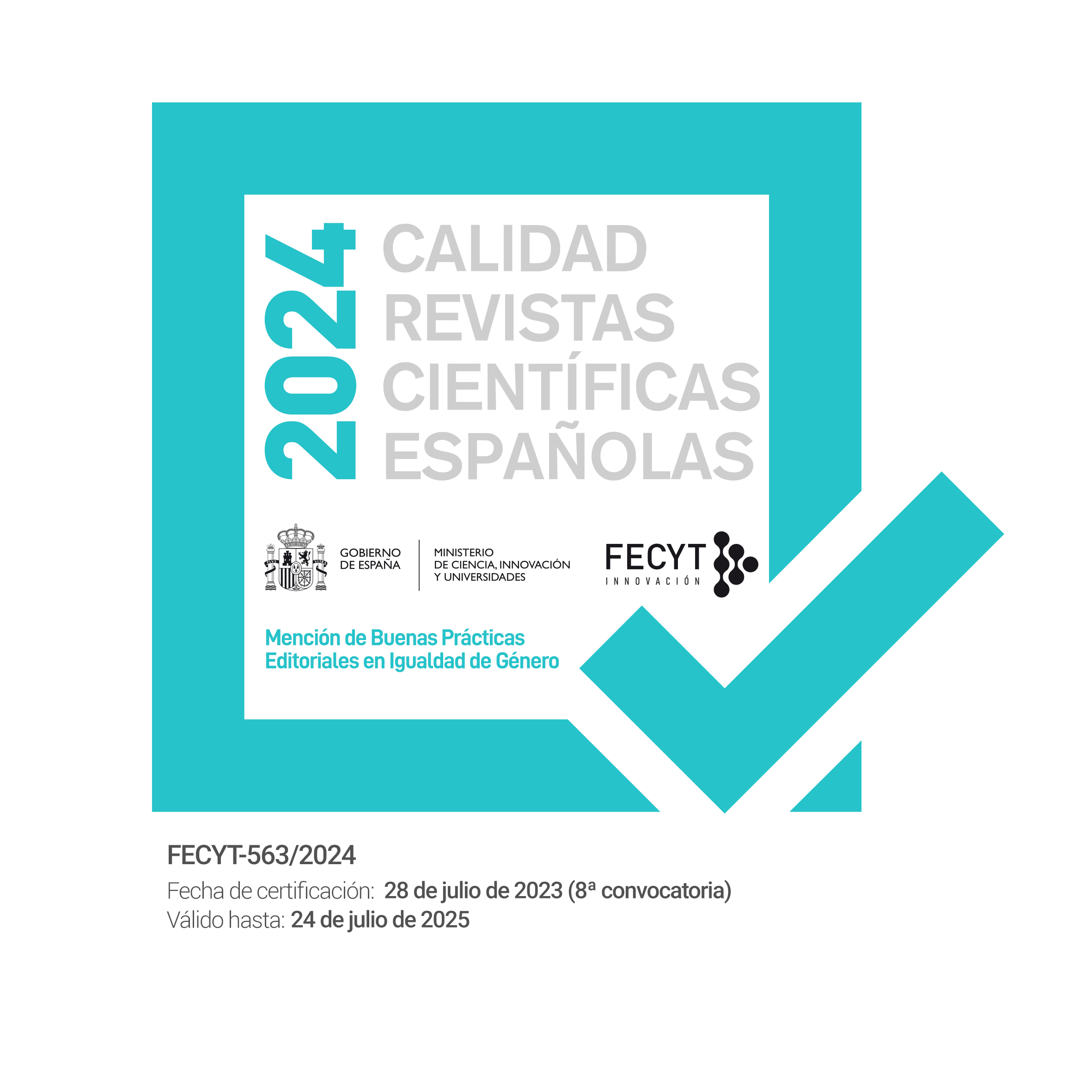Fatiga, calidad de vida y utilización de recursos sanitarios en niños con enfermedades crónicas complejas
DOI:
https://doi.org/10.23938/ASSN.1008Palabras clave:
Fatiga, Calidad de vida, Utilización de recursos, Enfermedad crónica, NiñoResumen
Fundamento. Nuestro objetivo fue determinar la fatiga en niños con enfermedades crónicas complejas (NECC) y analizar su asociación con características clínicas, sociodemográficas, utilización de servicios de salud y calidad de vida.
Material y método. Estudio transversal realizado en NECC atendidos en un hospital terciario durante 2016. Se determinaron la fatiga (cuestionario PedsFacit-F) y la calidad de vida (cuestionario PedsQL), y se recogieron las variables uso de recursos sanitarios, grupo de enfermedad, tiempo con la enfermedad, y nivel de estudios y ocupación profesional de los progenitores. Se elaboró un modelo de regresión múltiple para predecir el uso de recursos.
Resultados. Se incluyeron 70 niños, edad media 10,5 años (rango: 8-17), 41,4% niñas; la enfermedad oncológica fue la más frecuente (28,6%). El uso anual de recursos sanitarios (38,86; DE: 30,73) aumentó con la fatiga (r=-0,292; p=0,015). Las enfermedades oncológicas causaron más fatiga (24,9; DE: 10,7) que otras patologías y las cardiológicas menos (44,5; DE: 7,9). La calidad de vida percibida por NECC (20,6; DE: 16,5) correlacionó directa y significativamente (p<0,001) con la de sus progenitores (22,8; DE: 16,8); ambas se correlacionaron con la fatiga (r=0,528 y r=0,441; p<0,0001). El modelo de regresión lineal mostró que el efecto ajustado de mayor fatiga (menor puntuación), menor tiempo con la enfermedad y mayor nivel de estudios de la madre predijeron mayor uso de recursos de salud.
Conclusión. Los NECC con mayor fatiga hacen mayor uso de los recursos sanitarios, y perciben una peor calidad de vida, aspectos que deberían tenerse en cuenta a la hora de prestar atención a esta población.
Descargas
Citas
FEUDTNER C, CHRISTAKIS DA, CONNELL FA. Pediatric deaths attributable to complex chronic conditions: a population-based study of Washington State, 1980-1997. Pediatrics 2000; 106: 205-209. https://doi.org/10.1542/peds.106.S1.205
Children's Hospital Association. BERRY JG, AGRAWAL RK, COHEN E, KUO DZ. The Landscape of Medical Care for Children with Medical Complexity. Alexandria (VA): Children's Hospital Association, 2013. enlace
KUO DZ, BERRY JG, GLADER L, MORIN MJ, JOHANINGSMEIR S, GORDON J. Health services and health care needs fulfilled by structured clinical programs for children with medical complexity. J Pediatr 2016; 169: 291-296.e1. https://doi.org/10.1016/j.jpeds.2015.10.010
COHEN E, KUO DZ, AGRAWAL R, BERRY JG, BHAGAT SKM, SIMON TD, et al. Children with medical complexity: an emerging population for clinical and research initiatives. Pediatrics 2011; 127: 529-538. https://doi.org/10.1542/peds.2010-0910
COHEN E, BERRY JG, SANDERS L, SCHOR EL, WISE PH. Status Complexicus? The emergence of pediatric complex care. Pediatrics 2018; 141(Suppl 3): S202-211. https://doi.org/10.1542/peds.2017-1284E
INGERSKI LM, MODI AC, HOOD KK, PAI AL, ZELLER M, PIAZZA-WAGGONER C, et al. Health-Related quality of life across pediatric chronic conditions. J Pediatr 2010; 156: 639-644. https://doi.org/10.1016/j.jpeds.2009.11.008
O’CONNELL C, STOKES EK. Fatigue – concepts for physiotherapy management and measurement. Phys Ther Rev 2007; 12: 314-323. https://doi.org/10.1179/108331907X223100
CRICHTON A, KNIGHT S, OAKLEY E, BABL FE, ANDERSON V. Fatigue in child chronic health conditions: a systematic review of assessment instruments. Pediatrics 2015; 135: e1015-1031. https://doi.org/10.1542/peds.2014-2440
MCCABE M. Fatigue in children with long-term conditions: an evolutionary concept analysis. J Adv Nurs 2009; 65: 1735-1745. https://doi.org/10.1111/j.1365-2648.2009.05046.x
AMERINGER S, ELSWICK RK, SMITH W. Fatigue in adolescents and young adults with sickle cell disease: biological and behavioral correlates and health-related quality of life. J Pediatr Oncol Nurs 2014; 31: 6-17. https://doi.org/10.1177/1043454213514632
SILVA N, PEREIRA M, OTTO C, RAVENS-SIEBERER U, CANAVARRO MC, BULLINGER M. Do 8- to 18-year-old children/adolescents with chronic physical health conditions have worse health-related quality of life than their healthy peers? a meta-analysis of studies using the KIDSCREEN questionnaires. Qual Life Res 2019; 28: 1725-1750. https://doi.org/10.1007/s11136-019-02189-7
M BT, A LC, W VJ. Impaired health-related quality of life in children and adolescents with chronic conditions: a comparative analysis of 10 disease clusters and 33 disease categories/severities utilizing the PedsQLTM 4.0 Generic Core Scales. Health Qual Life Outcomes 2007; 5: 43. https://doi.org/10.1186/1477-7525-5-43
Observatorio de la Infancia y Adolescencia de Andalucía. Datos de población municipal 2015: Granada. Sevilla: Junta de Andalucía, 2016. https://www.observatoriodelainfancia.es/ficherosoia/documentos/4890_d_IPM_2015_GRANADA.pdf
DOMINGO-SALVANY A, BACIGALUPE A, CARRASCO JM, ESPELT A, FERRANDO J, BORRELL C. Proposals for social class classification based on the Spanish national classification of occupations 2011 using neo-Weberian and neo-Marxist approaches. Gac Sanit 2013; 27: 263-272. https://doi.org/10.1016/j.gaceta.2012.12.009
KLASSEN AF, ANTHONY SJ, KHAN A, SUNG L, KLAASSEN R. Identifying determinants of quality of life of children with cancer and childhood cancer survivors: a systematic review. Support Care Cancer 2011; 19: 1275-1287. https://doi.org/10.1007/s00520-011-1193-x
VARNI JW, SEID M, KURTIN PS. PedsQLTM 4.0: Reliability and validity of the Pediatric Quality of Life InventoryTM Version 4.0 Generic Core Scales in healthy and patient populations. Med Care 2001; 39: 800-812. https://doi.org/10.1097/00005650-200108000-00006
GONZÁLEZ-GIL T, MENDOZA-SOTO A, ALONSO-LLORET F, CASTRO-MURGA R, POSE-BECERRA C, MARTÍN-ARRIBAS MC. Versión española del cuestionario de calidad de vida para niños y adolescentes con cardiopatías (PedsQL TM). Rev Esp Cardiol 2012; 65: 249-257. https://doi.org/10.1016/j.recesp.2011.10.010
Peds FACIT-F: Pediatric Functional Assessment of Chronic Illness Therapy-Fatigue. https://www.facit.org/measures/peds-FACIT-F
LAI JS, CELLA D, KUPST MJ, HOLM S, KELLY ME, BODE RK et al. Measuring fatigue for children with cancer: development and validation of the pediatric Functional Assessment of Chronic Illness Therapy-Fatigue (pedsFACIT-F). J Pediatr Hematol Oncol 2007; 29: 471-479. https://doi.org/10.1097/MPH.0b013e318095057a
BEKTAS İ, KIR M, YILDIZ K, GENÇ Z, BEKTAS M, ÜNAL N. Symptom Frequency in children with congenital heart disease and parental care burden in predicting the quality of life of parents in Turkey. J Pediatr Nurs 2020; 53: e211-216. https://doi.org/10.1016/j.pedn.2020.04.01
SHIPPEE ND, SHAH ND, MAY CR, MAIR FS, MONTORI VM. Cumulative complexity: a functional, patient-centered model of patient complexity can improve research and practice. J Clin Epidemiol 2012; 65: 1041-1051. https://doi.org/10.1016/j.jclinepi.2012.05.005
BADAWY SM, THOMPSON AA, HOLL JL, PENEDO FJ, LIEM RI. Healthcare utilization and hydroxyurea adherence in youth with sickle cell disease. Pediatr Hematol Oncol 2018; 35: 297-308. https://doi.org/10.1080/08880018.2018.1505988
CHENG L, WANG Y, DUAN M, WANG J, WANG Y, HUANG H et al. Self-reported fatigue in chinese children and adolescents during cancer treatment. J Pediatr Oncol Nurs 2021; 38: 262-270. https://doi.org/10.1177/1043454221992304
KOHLI R, CHATURVEDI S. Epidemiology and Clinical manifestations of immune thrombocytopenia. Hamostaseologie 2019; 39: 238-249. https://doi.org/10.1055/s-0039-1683416
PÉREZ-ARDANAZ B, PELÁEZ-CANTERO MJ, MORALES-ASENCIO JM, VELLIDO-GONZÁLEZ C, GÓMEZ-GONZÁLEZ A, LEÓN-CAMPOS Á et al. Socioeconomic Factors and quality of life perceived by parents and children with complex chronic conditions in Spain. Children 2021; 8: 931. https://doi.org/10.3390/children8100931
HO KY, LI WHC, LAM KWK, WEI X, CHIU SY, CHAN CFG et al. Relationships among fatigue, physical activity, depressive symptoms, and quality of life in Chinese children and adolescents surviving cancer. Eur J Oncol Nurs 2019; 38: 21-27. https://doi.org/10.1016/j.ejon.2018.11.007
PINQUART M. Health-related quality of life of young people with and without chronic conditions. J Ped Psychol 2020; 45: 780-792. https://doi.org/10.1093/jpepsy/jsaa052
STORM VAN’S GRAVESANDE K, BLASCHEK A, CALABRESE P, ROSTÁSY K, HUPPKE P, KESSLER JJ et al. Fatigue and depression predict health-related quality of life in patients with pediatric-onset multiple sclerosis. Mult Scler Relat Disord 2019; 36: 101368. https://doi.org/10.1016/j.msard.2019.08.010
DI BATTISTA A, SOO C, CATROPPA C, ANDERSON V. Quality of life in children and adolescents post-TBI: a systematic review and meta-analysis. J Neurotrauma 2012; 29: 1717-1727. https://doi.org/10.1089/neu.2011.2157
HALL CA, DONZA C, MCGINN S, RIMMER A, SKOMIAL S, TODD E et al. Health-related quality of life in children with chronic illness compared to parents: a systematic review. Pediatr Phys Ther 2019; 31: 315-322. https://doi.org/10.1097/PEP.0000000000000638
THYGESEN LC, CHRISTIANSEN T, GARCÍA-ARMESTO S, ANGULO-PUEYO S, MARTÍNEZ-LIZAGA L, BERNAL-DELGADO E. Potentially avoidable hospitalizations in five European countries in 2009 and time trends from 2002 to 2009 based on administrative data. Eur J Pub Health 2015; 25 (Suppl 1): 35-43. https://doi.org/10.1093/eurpub/cku227
Publicado
Cómo citar
Número
Sección
Licencia

Esta obra está bajo una licencia internacional Creative Commons Atribución-CompartirIgual 4.0.
La revista Anales del Sistema Sanitario de Navarra es publicada por el Departamento de Salud del Gobierno de Navarra (España), quien conserva los derechos patrimoniales (copyright ) sobre el artículo publicado y favorece y permite la difusión del mismo bajo licencia Creative Commons Reconocimiento-CompartirIgual 4.0 Internacional (CC BY-SA 4.0). Esta licencia permite copiar, usar, difundir, transmitir y exponer públicamente el artículo, siempre que siempre que se cite la autoría y la publicación inicial en Anales del Sistema Sanitario de Navarra, y se distinga la existencia de esta licencia de uso.








